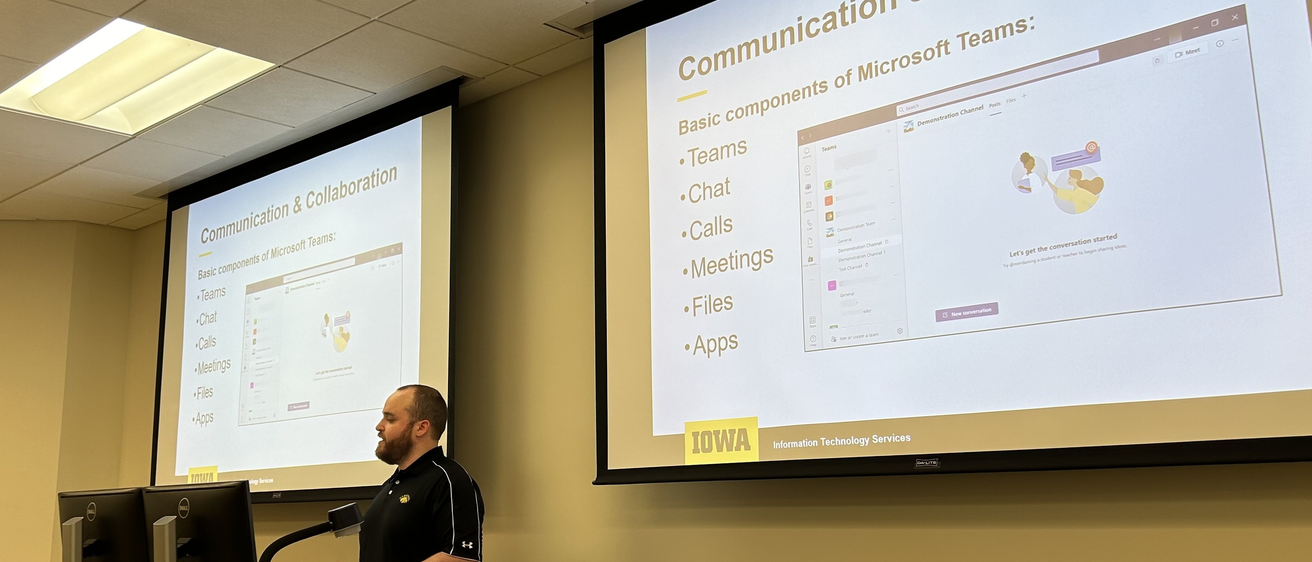
Breadcrumb
Collaboration grows with Microsoft Teams
Microsoft Teams is a central hub for many of the Microsoft 365 products with an emphasis on teamwork, and its use on campus grew steadily throughout 2023. As more campus users embrace it, IT professionals are working on plans to make it the primary platform for telephony and video conferencing.
Microsoft Teams is a powerful collaboration platform that brings together chat, video conferencing, file sharing, and integrated productivity tools. It is available to all students, faculty, and staff for free and is pre-installed on most university-managed machines. It’s also available online through Microsoft 365.
Nearly 16,000 internal users and 600 guests used the university’s Microsoft tenant in the past six months. Teams became available during the pandemic in 2020 and more people have used it each year.
Tracy Scott, executive director of ITS Enterprise Services, has frequently heard concerns over the years about having too many options for communication and collaboration. People get confused about which tool to use and when to use it.
“Skype for Business, Microsoft Teams, and Zoom have some overlapping capabilities, but they also don’t all quite do the exact same things,” Scott says. “When we look at those solutions across the board, Microsoft Teams has the most comprehensive set of features. It can do pretty much everything that all the other tools can do, as well as a lot more that those tools can’t. That prompted us to move toward Microsoft Teams as the primary solution going forward.”
Another reason to move toward Teams, Scott says, is that Microsoft has set an end-of-life date for October 2025, at which point the version of Skype for Business that the University of Iowa is on will no longer be supported. Microsoft Teams will eventually be the new telephony solution for campus.
ITS has been working to raise awareness of Microsoft Teams and making sure that people know that it is available to them here at the University of Iowa. Ryan Lenger, IT director of Enterprise Communication and Collaboration, says the plan is to introduce Teams unit-by-unit, making sure the technical support contacts and IT leaders for each area are ready for the transition.
“It usually takes a seed, a champion, in a department to realize what [Teams] could do and be the inside person who’s knowledgeable,” Lenger says.
Nicole Kallemeyn, associate professor of instruction and undergraduate program coordinator in the Roy J. Carver Department of Biomedical Engineering in the College of Engineering, has been using Microsoft Teams with her department since the pandemic began in 2020.
“For us, it was a way to stay connected when we were working remotely and not seeing everyone," Kallemeyn says. "It was a way to share information in a different way than we were able to before when we were mostly in person. We still actively use it, even though we’re back on campus for the most part.”
Kallemeyn says her department mainly uses Microsoft Teams to share general information reminders. She likes how information can be separated into different channels or categories. She created a channel for individuals working on a lengthy reaccreditation document. They used an app to set up a to-do list and a flow chart for the project, and were able to communicate and contribute together in real time.
In the past six months, more than 3.2 million chat messages were sent, 183,000 channel messages were posted, and 67,000 meetings were hosted on the university's Teams tenant.
“I think those numbers are telling a story that people get a foot in the door for one reason and then start to realize how much more Microsoft Teams can do,” Lenger says. “They slowly build and expand over time.”
As more people start to use Microsoft Teams, the need for support grows as well. Because Teams is always changing and adding new features, ITS relies on Microsoft quite a bit for documentation and training. Lenger and his team have also documented and built web pages on the ITS website with instructions unique to the University of Iowa, such as how to log in to Microsoft Teams with a HawkID and password.
The Campus Technology Training group within ITS Enterprise Services offers instructor-led classes on Microsoft Teams (and other services), as well as how-to videos and PDF guides. This group also highlights resources through LinkedIn Learning, which has many courses on Microsoft Teams.
Lenger says the training and resources provided by ITS are meant to serve as a breadcrumb trail that piques a user’s interest and lets them know there is always more to learn.
“Our training is designed to meet people where they are,” Lenger says. “We want them to feel comfortable using the tools that can empower their work.”